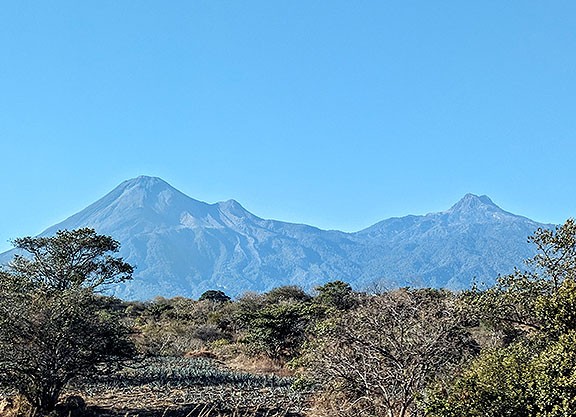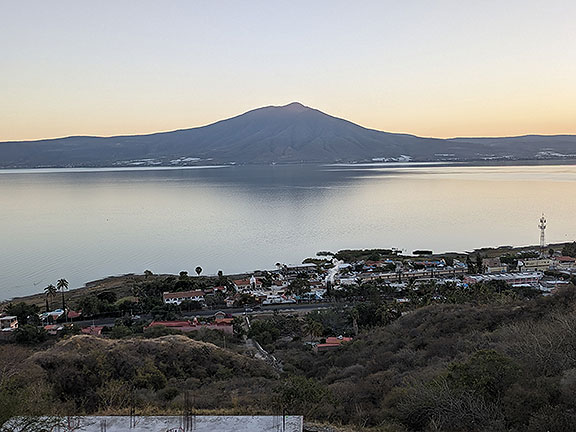
Recent mural in San Francisco
There’s a lot of hand-wringing these days over the likelihood of Trump’s return to power. I find it hard to imagine that a majority of voters would choose him. Then again, I find it hard to believe that anyone thinks well of Joe Biden or the Democrats, given their blind support for the fascistic Netanyahu and their active participation in the genocidal campaign in Gaza, and their belligerent expansion of hostilities across the Middle East in the past months. The cash cow of arms expenditures unleashed by the Ukraine-Russia war is yet another example of the Democratic Party’s dependence on “military Keynesianism,” an economic program going back to WWII. I wrote about the war-mongering reality of the United States a couple of years ago, but I’m taking it up again after a few recent books I read.
In The Jakarta Method, Vince Bevins does a great job of summarizing the wholesale mass murder that was at the heart of U.S. Cold War policies.
…in the years 1945-1990, a loose network of US-backed anticommunist extermination programs emerged around the world, and they carried out mass murder in at least twenty-three countries. There was no central plan, no master control room where the whole thing was orchestrated, but I think that the extermination programs in Argentina, Bolivia, Brazil, Chile, Colombia, East Timor, El Salvador, Guatemala, Honduras, Indonesia, Iraq, Mexico, Nicaragua, Paraguay, the Philippines, South Korea, Sri Lanka, Sudan, Taiwan, Thailand, Uruguay, Venezuela, and Vietnam should be seen as interconnected, and a crucial part of the US victory in the Cold War. (p. 238) …this loose network of extermination programs, organized and justified by anticommunist principles, was such an important part of the US victory [in the Cold War] that the violence profoundly shaped the world we live in today. (p. 239)
It’s a gripping claim and I think it’s indisputable. What Bevins does not try to do, but his book provides an important piece of foundational continuity for, is to show how the extermination campaigns under the aegis of “anti-communism,” while barbaric and largely ignored, denied, or immediately forgotten, were built on the same logic that has been running through U.S. history since its founding. The genocidal slaughter of American Indians begins well before the founding of the country in the late 18th century (not to mention the role of slavery in providing the capital to launch the industrial revolution). But as the post-Civil War wars were unleashed by the newly victorious and industrializing federal government, systematic extermination was the result in California and elsewhere.

There’s a wonderful exhibit of Bonnie Ora Sherk’s work at Fort Mason right now.
Jonathan M. Katz’s 2021 book on General Smedley Butler, Gangsters of Capitalism, fills in another chapter in this sordid history. Butler started out a teenage Quaker anxious to earn his manhood by going to a “good war” to “liberate” Cuba from Spain in 1898. From there his life as a Marine goes on, most immediately being sent to the Philippines where a war of national liberation that the United States had initially claimed to support soon became an extended counterinsurgency effort for the U.S. military. During the next three decades, Smedley Butler climbed the ranks of the Marines while being put in the middle of one horrifying U.S. intervention after another. He was in Panama when with U.S. support they broke away from Colombia and became a separate nation just in time to sign a treaty giving the United States sovereign control over the Canal Zone (where they then built the Panama Canal). He was among the troops invading Nicaragua in the 1910s and installing a U.S.-friendly leader. He participated in the attack and invasion of Mexico in 1915, he became the defacto military leader of Haiti in the late 1910s and early 1920s. He was in China a couple of times, first to protect U.S. businesses during the Boxer Rebellion in early 1900s, then in 1927 as the forces under Chiang Kai-Shek unleashed a force of criminal gangs to carry out a wave of mass murder against the Communist Party of China in Shanghai. He even helped set the stage for the militarization of domestic policing during a stint as the head of Philadephia’s police. And there’s more (but you’ll have to read the book).
Katz sums up Butler’s role:
Smedley Butler had led troops on the bankers’ behalf to overthrow presidents in Nicaragua and Honduras, and gone on a spy run to investigate regime change on behalf of the oil companies in Mexico. He had risked his Marines’ lives for Standard Oil in China and worked with Murphy’s customs agents in an invasion that helped lead to a far-right dictatorship in the Dominican Republic. In Haiti, Butler had done what even the Croix de Feu and its French fascist allies could not: shut down a national assembly at gunpoint. (p. 325)
Butler’s most lasting mark on Haiti was the Gendarmerie. Following the example Trujillo set with the expansion of his Guardia Nacional in the Dominican Republic, near the end of the occupation the Gendarmerie was reorganized into a new national army, the Garde d’Haiti. “We cannot overemphasize the fundamental political difference between the Garde and the army that was dismantled by the Marines,” [Haitian historian] Michel-Rolph Trouillot wrote. While Haiti’s original army “saw itself as the offspring of the struggle against slavery and colonialism. . . the Haitian Garde was specifically created to fight against other Haitiians. It received its baptism of fire in combat against its countrymen. And the Garde, like the [new] army it was to sire, has indeed never fought against anyone but Haitians. (p. 250)

Had a nice short trip to Mexico in the first week of February. Here’s the still active Colima Volcano (left) and the dormant Nevada volcano (right).
The current nightmare in Haiti, rooted in two centuries of retribution for their successful revolution, is based on continual U.S. interventions to prop up corrupt dictators and puppet politicians. Smedley Butler was there at the beginning of the 20th century to set up not just the ongoing exploitation of Haiti, but he and the State Department presided over the firm partitioning of the island between Haiti and the Dominican Republic, two countries that should have a lot more in common than not, but have been kept at odds by decades of U.S. intervention.>
Eventually Butler is recruited to lead a fascist coup in the United States by anti-New Deal rightwingers in the early 1930s, but he reveals all in testimony to Congress. It gets flushed from the news and popular awareness almost immediately, leading him to realize what the real purpose of all these military interventions was.
In 1935 he wrote a book, War is a Racket, that is still in print today where he confessed:
“I spent 33 years and 4 months in active service as a member of our country’s most agile military force—the Marine Corps. I served in all commissioned ranks from a second lieutenant to Major-General. And during that period I spent most of my time being a high-class muscle man for Big Business, for Wall Street and for the bankers. In short, I was a racketeer for capitalism.”

A wired pineapple? in Ajijic?

A clear February day from Billy Goat Hill in San Francisco. Mt. Diablo visible in distance.
I was listening to a podcast called History Against the Grain and their latest installment (#67) is called “The Banality of Nationality.” They spent a good deal of it lambasting former George W. Bush speechwriter David Frum for his recent Atlantic, article defending the indefensibly racist President Woodrow Wilson (the same president who screened Birth of a Nation as the first film ever shown at the White House and was an undisguised segregationist). Their take was a good example of how much the efforts of the Right to suppress scholarship that takes issue with the dogged self-congratulatory tropes of American Exceptionalism are just not working. Somehow Frum has managed to re-emerge in the Trump era as a vaguely liberal pundit, but the guys on this show do a good job of ripping that civilized facade away.
Frum, according to the guys on this podcast, wants to say that there are some timeless values of Americanism that he thinks Wilson embodied, and that critics on the left and right have “canceled” him with their “presentist” arguments. But Frum’s suggestion of fundamental American goodness is precisely what the podcasters want to demolish. If you look at the long history of the United States, in spite of the persistence of claims to being an “exceptional” country that is somehow always bending with the arc of history towards justice, the mass violence, plunder, and terrorism inflicted on countless millions of people around the world is impossible to reconcile with these claims. Spencer Ackerman’s Reign of Terror starts off with his confession that he “swallowed that red pill myself” after 9/11.
In retrospect, any failure—especially by the war’s architects, stewards, and chroniclers—to see that the War on Terror was seeding the ground for a figure like Trump testifies to the power of American exceptionalism, which is nothing more than white innocence applied globally. (p. xvi)
Ackerman focuses his analysis on the first two decades of the 21st century, and shows how the insanity of the Bush/Cheney wars set the stage for Trump (not to mention how Obama before and Biden after both show more continuity with Trump than not). The palpable madness of Trump is a symptom of the deep insanity that the entire ruling class bought in to going back to the declaration of a “war on terror” by George W. Bush. The maintenance of the supremacy of militarism at the heart of the Federal government is a project that has been pursued by every president since FDR. The post-WWII security state and ensuing Cold War cemented the military-industrial complex at the crux of policy making. Ackerman reserves some of his ire for the so-called #Resistance that emerged during the Trump administration:
What became known as the #Resistance on Twitter was a mockably earnest expression of, most often, white bourgeois outrage at Trump. Its adherents tended to surgically separate their hatred of Trump from any examination of the America that produced him. That exceptionalist position inclined the #Resistance to favorably view the FBI no longer as Hillary Clinton’s irresponsible persecutor but as the swift blade of justice dangling above Trump’s criminal reign. The FBI, the CIA, the NSA, and the Justice Department were the foundations of the rule of law, not manipulators, torturers, serial violators of fundamental constitutional liberties, and justifiers. To the #Resistance which heeded figures like the NSA and CIA’s Hayden, Iraq warmonger Bill Kristol, and Clapper, Trump’s clash with the Security State testified to the virtues of the Security State. . . There is hardly a single bad deed that Trump has or intends to carry out that does not have roots in policies championed by prior administrations… The #Resistance cheered on the “Adults In The Room” without considering that an earlier set of adults, the adults they esteemed, had already prepared the room. (p. 286-287)

Gorgeous tree in Colima.
All presidents since WWII have prioritized an endlessly expanding military budget as the motor of the U.S. economy and the necessary foundation for world hegemony. That U.S. hegemony is noticeably fraying since the turn of the century, which seems to be Biden’s main preoccupation (as it was ostensibly Trump’s and Obama’s and Bush’s). Obama authorized a trillion dollar “modernization” of the nuclear arsenal, still the only guarantor the ruling class believes in to keep the U.S. on top. Trump authorized his own series of nuclear war preparations, and now Biden is doing the same.
I have a friend in Scotland who has put nuclear war and nuclear bombs front and center in his organizing since a few years ago. At first I was a bit puzzled, since the presence of those weapons has been unchanging for decades. Given how steadily we are marching towards war, though, and the insanity of the Generals and the politicians who egg them on, re-examining the insanity of nukes is overdue. After all, the years that we survived dozens of accidents involving nuclear-tipped missiles is not so long ago. Eric Schlosser, a great writer who had success originally with his Fast Food Nation exposé in 2001, wrote a fascinating and penetrating look at the nuclear bomb industry, and one of the worst accidents to ever happen, in Command and Control: Nuclear Weapons, the Damascus Incident, and the Illusion of Safety.
It’s a harrowing account of the near detonation of a nuclear weapon in a silo in Arkansas. He also explains many other incidents where nuclear-tipped bombs fell out of planes, notably in Andalucia in Spain in the 1960s. Luckily none of them detonated. But what stuck with me was how normal and routine accidents involving nuclear weapons turn out to be:
… a study of abnormal environments commissioned by Sandia soon found that at least 1,200 nuclear weapons had been involved in “significant” incidents and accidents between 1950 and March 1968. (p.327)
On the cusp of another push to expand “civilian” nuclear power, along with the ongoing insanity of building and expanding the wildly redundant nuclear arsenal, isn’t it obvious that we are inflicting harm on ourselves? If you saw the Chernobyl miniseries you may have some sense of the harrowing future the next accident(s) will impose. (A quick reminder: nuclear power is far and away the stupidest method of boiling water ever invented!) Any kind of nuclear war spells doom for a large part of the earth and everything that lives on it now. The ongoing collapse of biodiversity, while horrendous, is still a long way from what might happen in the event of a nuclear exchange.
Meanwhile, our cultural predilection for self-harm continues unabated. A teenage suicide epidemic clearly connected to the alienation induced by heavy social media use is growing steadily worse. The social policy to slaughter 40,000 people a year on the highways and streets of the U.S. continues unchallenged. The expulsion of millions of people from shelter and into the streets is another example of a self-destructive social policy. Giving support to bring five million children out of extreme poverty (but not into a life of comfort and abundance, which would be possible if we only wanted to) was a good way to address the pandemic dislocations. Why let it expire? Now those same kids are thrown back into penury (along with their parents). Then the mass shootings, perhaps the most direct manifestation of the war coming home, continue to accelerate, the latest being at the end of the Super Bowl parade in Kansas City. But it’s happening daily and the carnage is mind-boggling. Aggressive white supremacism is having its day. But it already had the past two and a half centuries (or more), so this feels more like a last gasp than a true moment of consolidation and advance for these reactionaries.

This Great Kiskadee came and posed for me near Lake Chapala.
There is no doubt that things continue to trend worse, and that there is nothing to point to in terms of broad powerful social movements that might be able to arrest and reverse our trajectory. And yet, like a lot of people, I have this sense that there is a deep volcanic upwelling that could emerge, something I encounter in everyday life all the time. The kind of solidarity and mutual aid and kindness and compassion that continues to reverberate among normal people despite the tangible insanity of those in power. People with a visceral hatred for cruelty, for racism, for misogyny, etc. People know we can get along. There’s not a lot of agreement on what is blocking us from doing so, but maybe the ferment and remarkable output from critical historians that has led to such profound accounts of the long march of barbarism carried out by the United States will ultimately have its effect. I sure hope so!

Lake Chapala at dusk.

Street art in San Francisco.












Essays of this highest quality need reaction, even if it is going to be the same tiresome groove of collapse.
You say that you would welcome a “deep volcanic upwelling,” and that you find many instances in everyday life of such a process, but volcanoes, to be tediously literal , produce lava of 1200 to 1300 degrees, much, much too hot for any social reality change that you hope against hope can somehow magically occur.
Gray Brechin has a SF-related column in today’s Counterpunch that accords more with my doomist dirge.